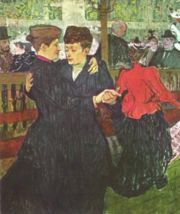Modern art is a general term used for most of the artistic production from the late 19th century until approximately the 1970s. (Recent art production is more often called Contemporary art or Postmodern art). Modern art refers to the then new approach to art where it was no longer important to represent a subject realistically — the invention of photography had made this function of art obsolete. Instead, artists started experimenting with new ways of seeing, with fresh ideas about the nature, materials and functions of art, often moving further toward abstraction.
History Roots in the 19th century

By the late 19th century, several movements which were to be influential in modern art had begun to emerge: Impressionism, centered around Paris, and Expressionism, which first emerged in Germany.
The influences were varied: from exposure to Eastern decorative arts, particularly Japanese printmaking, to the colouristic innovations of Turner and Delacroix, to a search for more depiction of common life, as found in the work of painters such as Jean-François Millet. At the time, the generally held belief was that art should be accurate in its depiction of objects, but that it should be aimed at expressing the ideal, or the domestic. Thus the most successful painters of the day worked either through commissions, or through large public exhibitions of their own work. There were official government sponsored painters' unions, and governments regularly held public exhibitions of new fine and decorative arts.
Thus, breaking with idealization and depiction were not merely artistic statements, but decisions with social and economic results.
These movements did not necessarily identify themselves as being associated with progress, or personal artistic freedom, but instead argued, in the style of the times, that they represented universal values and reality. The Impressionists argued that people do not see objects, but only the light which they reflect, and therefore painters should paint in natural light rather than in studios, and should capture the effects of light in their work.
Impressionist artists formed a group to promote their work, which, despite internal tensions, was able to mount exhibitions. The style was adopted by artists in different nations, in preference to a "national" style. These factors established the view that it was a "movement". These traits: establishment of a working method integral to the art, establishment of a movement or visible active core of support, and international adoption, would be repeated by artistic movements in the Modern period in art.
Early 20th Century
Among the movements which flowered in the first decade of the 20th century were Fauvism, Cubism, Expressionism and Futurism.
World War I brought an end to this phase, but indicated the beginning of a number of anti-art movements, such as Dada and the work of Marcel Duchamp, and of Surrealism. Also, artist groups like de Stijl and Bauhaus were seminal in the development of new ideas about the interrelation of the arts, architecture, design and art education.

Modern art was introduced to the United States with the Armory Show in 1913, and through European artists who moved to the U.S. during World War I. It was only after World War II, though, that the U.S. became the focal point of new artistic movements. The 1950s and 1960s saw the emergence of Abstract Expressionism, Pop art, Op art and Minimal art; in the late 1960s and the 1970s, Land art, Performance art, Conceptual art and Photorealism emerged.
Around that period, a number of artists and architects started rejecting the idea of "the modern" and created typically Postmodern works.
Starting from the post-World War II period, fewer artists used painting as their primary medium; instead, larger installations and performances became widespread. Since the 1970s, new media art has become a category in itself, with a growing number of artists experimenting with technological means such as video art.
CriticismModern art was heavily criticised (some would say misunderstood) while it was being produced. People complained that modern art was indistinguishable from non-art (such as a solid-coloured canvas, a pile of assorted objects, random cacophony (in the case of music) or, in the case of performance art, a mentally ill person). Although some works of modern art received critical acclaim, disapproval was the most common reaction among the general public. Much of the work produced could only be appreciated by other artists, or could not be understood without reading the artist's statement, a text that explained what the art "meant". This era was not the first time that the public could not understand contemporary art (for instance, the works of Mozart were considered challenging to listen to when they were first introduced), but it is the most notable. Modern art may have received a boost from an unlikely quarter: the Nazis set up public exhibitions to mock modern art as "degenerate", and when it became popular to eschew any behaviour that was similar to that of the Nazis, censorship and intolerance decreased throughout the Western world.
Artists have often had an uneasy relationship with their critics. The artist usually needs positive opinions from the critic for their work to be viewed and purchased but it may be some time before a new form of art is properly understood and appreciated. Some critics are unable to adapt to new movements in art and allow their opinions to override their objectivity, resulting in inappropriately dated critique. John Ruskin famously compared one of James Whistler's paintings to "flinging a pot of paint in the public's face".


2 comments:
Leave it to the photographers to screw up existing definitions of art. :)
Greg
http://journals.aol.com/radar446/PhotoTrek/
Oh yes, Greg;) Lets blame the photographer ..... for us not having talent to draw or paint. hehehe
Ann
Post a Comment